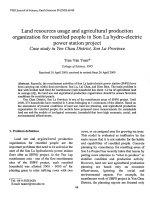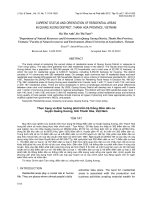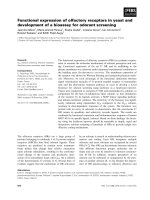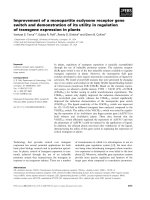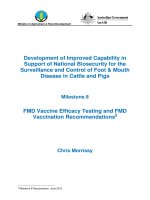Conservation and development of medicinal plants in long sap commune son la province
Bạn đang xem bản rút gọn của tài liệu. Xem và tải ngay bản đầy đủ của tài liệu tại đây (1.95 MB, 53 trang )
MINISTRY OF AGRICULTURE AND RURAL DEVELOPMENT
VIETNAM NATIONAL UNIVERSITY OF FORESTRY
----------
STUDENT THESIS
CONSERVATION AND DEVELOPMENT OF MEDICINAL PLANTS
IN LONG SAP COMMUNE, SON LA PROVINCE
Major : Natural Resource Management
Code: D850101
Faculty : Forest Resource and Environment Management
Student: Tran Ngoc Huyen
Student ID: 1253091360
Class: K57 Natural Resources Management
Course: 2012 – 2016
Supervisor: Assoc.Prof.Dr. Hoang Van Sam
Ha Noi, 2016
ACKNOWLEDGENTS
I would first like to thank my thesis advisor Assoc. Prof. Dr Hoang Van Sam at
Vietnam National Forestry University. The door to Assoc. Prof. Dr Sam office was always
open whenever I ran into a trouble spot or had a question about my writing. He
consistently allowed this paper to be my own work, but steered me in the right the
direction whenever he thought I needed it.
I would also like to thank the experts who were involved in the validation survey
for this research project: the teacher in Viet Nam forestry university have imparted to us
the knowledge to perform this topic. Thanks Long Sap commune People‟s Commitee Moc Chau District- Son La, the Border Post of Long Sap International Border Gate of
Vietnam, the Northwest Science Forest Center, the Forest Proctection Department of Son
La and the healers of Long Sap commune has facilitated to help us complete this thread.
During the topic implementing process, even though I had a lot of effort, because
of time and professional qualifications is limited, and the initial unfamiliarity acquainted
with the actual work, so my research subject inevitable shortcomings. I am looking
forward to receive some comments of teachers for our subject more perfect.
Sincerely thank you!
i
TABLE OF CONTENTS
ACKNOWLEDGENTS .......................................................................................................... i
LISTS OF TABLES AND CHARTS ................................................................................... iv
LIST OF ABBREVIATION .................................................................................................. v
INTRODUCTION ................................................................................................................. 1
CHAPTER I. OBJECTIVE, CONTENT .............................................................................. 3
1.1.Objectives ........................................................................................................................ 3
1.2.Reseach contents .............................................................................................................. 3
1.3.Scope:............................................................................................................................... 3
CHAPTER II. METHOD OF RESEARCH ......................................................................... 4
2.1. Inherited Methods ........................................................................................................... 4
2.2 Method of external investigation. .................................................................................... 4
2.3. Method of investigation about medicinal plants diversity and the origin ....................... 6
2.4. Determination of the medicinal plant species at risk of extinction method .................... 6
2.5. Method of investigation to make proposals for conservation and development of local
medicinal plants as well as the knowledge to use them ......................................................... 6
CHAPTER III. OVERVIEW OF RESEARCH ..................................................................... 7
3.1. International research ...................................................................................................... 7
3.2. Research in Vietnam ....................................................................................................... 8
CHAPTER IV. RESEARCH AREA ................................................................................... 10
4.1. Natural condition .......................................................................................................... 10
4.2. Residential situation ...................................................................................................... 10
4.3. Customary practices ...................................................................................................... 12
CHAPTER V: RESULT AND DISCUSSION .................................................................... 15
5.1. Diversity medicinal plant taxa ...................................................................................... 15
ii
5.2. Diversity about medical plant family............................................................................ 17
5.3. The source of medicinal plant ....................................................................................... 18
5.4. Diversity about life forms of medicinal plant ............................................................... 20
5.5. Different parts of plant treat different diseases ............................................................. 20
5.6. Conservation status ....................................................................................................... 22
5.7. Diversity of function uses ............................................................................................. 23
5.8. The knowledge of local people ..................................................................................... 24
5.9. Method of using medicinal plant .................................................................................. 26
CHAPTER VI. CONCLUSION AND RECOMMENDATION ........................................ 28
6.1.Conclusion ..................................................................................................................... 28
6.2.Recommandation ........................................................................................................... 28
APPENDIX I ....................................................................................................................... 30
APPENDIX II ...................................................................................................................... 40
REFERENCES
iii
LISTS OF TABLES AND CHARTS
Table 1: Diversity of taxa .................................................................................................... 15
Table 2: Top 10 families with the highest number of medicinal species ............................ 16
Table 3: Comparing the medicinal plant system Long Sap commune with the medicinal
plant system of Vietnam. ..................................................................................................... 17
Table 4: Ratio of top 10 families have highest species........................................................ 18
Table 5: Life form of herbaceous medicinal plant in Long Sap Commune ........................ 20
Table 6: Diversity of parts used‟s medicinal plant in Long Sap commune ......................... 20
Table 7: Diversity of plant parts used drugs. ....................................................................... 21
Table 8: List species in red book data.................................................................................. 22
Table 9: List of diseases....................................................................................................... 23
Table 10 : Distribution of survey respondents by age ......................................................... 25
Chart1: The source of meidicinal plant in Long Sap cummnune ........................................ 19
Chart 2 : Distribution of survey respondent by sex ............................................................. 25
iv
LIST OF ABBREVIATION
C
Cultivated
EN
Endangered
H
Herb
K
Insufficiently known
L
Liana
LC
Least concern
S
Shurb
T
Threatened
W
Wood
WHO
World Health Organization
Wi
Wild
v
INTRODUCTION
Vietnamese has 4000 years and more of history, there are many traditionals in
building the country, fighting enemy and cutural development. In this process we have
many experiences in disease prevention and treatment to protect the health from natural
wild medicinal plants.
Nowadays, although we got many sucess in modern medicine,
traditional
medecine has always existed and go abreast.
Vietnam is a tropical country, has the rich of vegetational cover with a variety of
medicinal plants. We have 54 ethnic goups live together, each goups has their own
traditional culture and experience in heathy care. Many precious medical plants and
folklores in using traditional medicine of ethnic minorities, especially in northwest dosen‟t
have many documents mention. Futhermore, due to the impact of market economy, the
develop of human, and the appearances of medicines which very easy to buy and use. In
other hands, the young people nowadays don‟t care about the experience of disease
prevention and treatment by medicines and methods of previous generation. So treasure of
folk medicine knowledge in danger of being eroded. The conservation and development of
medicinal plants are imperative that our government has been very concerned.
From the base on I do the thesis: “Conservation and development of medicinal
plant in Long Sap commune, Son La province”
Long Sap is a border commune in Son La province, the west border by Laos.
decent terrain, steep slopes, low temperature, high elevation above sea level. Long Sap has
climatic characteristics suitable for the growth and development of many types of plants.
Long Sap is a mountainous commune with poor facility. They have only one health center
and do not have any pharmacy. So local people usually use medical plant in healing and
protect health in the guidance of staff‟s health center or healer( thầy lang). That is the
1
reason why medicinal plant are appreciated in Long Sap commune. In the 4th conference
the VII central committee of the communist Party of Vietnam give resolution about the
urgency of the problem of caring and protecting people‟s health, in which stating the
problem should: “ combine closely modern medicine with traditional medicine, deploy
robust research, applications and modernize traditional medicine, combining modern
medicine, development of crops and livestock as drugs, equipment and facilities for the
treatment and production of traditional medicines. Urgently training staff and top experts
in traditional medicine, increase investment and upgarde traditional medicine
establishment, in order to make the best of facilitate the clinical development od traditional
medicine, to meet the requirement of the strata.
2
CHAPTER I.
OBJECTIVE, CONTENT
1.1.Objectives
-Conservation and development of medicinal plants in Long Sap, Son La province
- Assessment the status of medicinal plants
in Long Sap commune, Son La
province
- Understanding the indigenous knowledge on using medicinal plant in Long Sap
commune, Son La province
- Provide solution for conservation and development of medicinal plants in Long
Sap, Son La province
1.2.Reseach contents
- To study diversity of medicinal plant in Long Sap commune, Son La province.
- To study experience on using and processing of medicinal plant in the research
area.
-Research on challenge and oppotunity for development of medicine plants in Long
Sap commune.
-Propose solution to conserve and develop medicine plants diversity in Long Sap
commune.
1.3.Scope:
14 villages of Long Sap commune, Son La province:
Phat hamlet, Bo Sap hamlet, Phieng Cai hamlet, Buoc Pat hamlet, Pha Nhen
hamlet, A La hamlet, Pu Nhan hamlet, Co Chay hamlet, Hong Hua hamlet, Buoc Quang
hamlet, Pha Don hamlet, A Ma 1 hamlet, A Ma 2 hamlet, Muong Bo hamlet.
3
CHAPTER II.
METHOD OF RESEARCH
2.1. Inherited Methods
- The data on natural conditions, climate, hydrology, soil, topography, forest resources
- Information and data on economic, condtions, social conditions
2.2 Method of external investigation.
Interview form 1:
Questionnaires for local officials
1. Investigations unit:........................................................................................
2. Full name:......................................................................................................
3. Career:..........................................................................................................
4. Regency:......................................................................................................
5. Age of people in commune.........................................................................
Over 60 years old:......................................................................................
45-60 years old:.........................................................................................
30-45 years old:........................................................................................
15-30 years old:........................................................................................
Under 15 years old:...................................................................................
6.
Job specification of local people
Agricultural:.................................%
Handicraft:...................................%
Business:.....................................%
Physic:.........................................%
7. How many people who participation of private medical treatment:
8. Does Long Sap commune have traditional medicine association?
Yes
No
4
9. If Long Sap has, how does it work?
10. Do you have any suggestion for develop traditional medicine?
Interview form 2:
HOUSEHOLD INTERVIEW
1.
Full name:...................................................................................
2.
Age:............................................................................................
3.
Sex: Male/ Female
4.
Career:
-
Agriculture:
- Official
- Other (specify)
Bussiness:
5. Ethnic group have:
Fullname
Age
Sex
Male
Female
Symptom
5. Remedy
-
Use medicine
-
Other:
-
Why did you choice this remedy?
- Dont use medicine
6. Result
5
Disease duration
2.3. Method of investigation about medicinal plants diversity and the origin
-
Interviewing the healer, the family of healer ( who take care of the healer in the
healing period) and the people who grow and harveste the medicine plant to find
out:
+ Is this species planted or grow naturally
+ Where dose it concentrate
-
And combined with field surveys in research area.
-
Use Tomachoff formular to calculate calculate the diversity of family floral in
tropical region:
-
P%= n.100/N
-
P%: the ratio % of 10 families which have the most species in surveying
-
n : the number of 10 families which has the most species in surveying
-
N: Total of species in surveying
2.4. Determination of the medicinal plant species at risk of extinction method
-
Statistics, recorded medicinal plants , assess their abundance, combined with
interviews local people to compare numbers of medicinal species now to before.
-
After that check the status of that medicinal plants in IUCN rest list or go to the
link http: // www.iucnredlist.org/search, put the name of the species that I want to check in
the blank: “ enter red list search term” and press “go” to find out.
2.5. Method of investigation to make proposals for conservation and development of
local medicinal plants as well as the knowledge to use them
-
Interview with extension staff, forestry extension of Long Sap commune
interviewing local people and assessing the status of medicinal plants.
-
Interviews to learn about the aspirations of the people, contribute to the
preservation of indigenous knowledge on medicinal plant use of local people.
6
CHAPTER III. OVERVIEW OF RESEARCH
3.1. International research
Traditional medicine developed over generations within various societies before the
eara of modern medicine. The WHO defines traditional medicine as "the sum total of the
knowledge, skills, and practices based on the theories, beliefs, and experiences indigenous
to different cultures, whether explicable or not, used in the maintenance of health as well
as in the prevention, diagnosis, improvement or treatment of physical and mental illness.
In developing countries where have a third of population have no access to modern
medicine and providing safe and effective of traditional medicine has become an effective
tool for the treatment diseases. In Butan has more than 2.990 medicinal plants are used,
about 70% dried herbal raw materials can be used immediately, more than 300 herbal
products are manufactured in here. In Africa, 80% population choiced traditional medcine
in take care of health. Even in countries has developing mordern medicine as Europe,
North American or industrialized countries have 50% population used traditional medicine
at least once time.
Traditional medicine has been trusted in many regions, this thing are showed in the
increase in the value of trade exchange market. In American, 1991, sales of traditional
medicines is estmated at $ 1 billion. In report of WHO total money pay for traditional
medicine in all around the world at $ 60 billiond/ year and has the increasing trend.
Traditional medicine is not only effective in primary health care but also, nowadays
in all around the world when pandemic HIV- AIDS are complicated, traditional method is
the choice in many regions because of safety, inexpensive and its benefits. Estimate that in
San Francisco, London and South Africa have 75% people who are HIV/AIDS choice
traditional medicine as tonic, enhance energy, get better digestion.
7
Besides the positive traditional medicine many coutries are not truly recognized
especially in the era filled with modern medicine. Although exist in many countries,
traditional medicine has not been incorporated into national health system.
Summary, beside the strongly development of modern medicine, traditional
medicine with everlasting life keeps asserting itself indispensable role in Healt care of all
coutries.
3.2. Research in Vietnam
For several thousand years, Vietnamese Traditional Medicine has evolved under
the shadows of Chinese Traditional Medicine, culture, and rule. At this point in time, it is
nearly impossible to separate out and delineate Traditional Vietnamese Medicine or Thuoc
Nam (Southern Medicine) from Traditional Chinese Medicine or Thuoc Bac (Northern
Medicine) because their developments were so inter-twined. This is a brief history of the
development of Thuoc Nam and its influences particularly by Southern China.
What is generally considered classical Vietnamese culture started in the northern
third of Vietnam. This area was very much connected to China and Chinese culture even
before the 4th or 5th century B.C. During that time period, southern China, from the
Yangtze River to the northern part of VN, was one large ecological region. There were a
number of different ethnic groups living in this fertile region who were not considered
Chinese by Northern Chinese. Among these groups was the „Yue,‟ the Chinese word for
Viet. Northern Vietnam and Southern China came under Chinese rule by the 4th century
B.C.
Medical texts and instruments found in Northern Vietnam have been shown to
predate Chinese conquest, suggesting that Vietnamese people already had a developed
system of medicine. In addition, among Chinese medical texts from the 4th century B.C.,
references were given to the “Yue Prescriptions,” indicating that Thuoc Nam was an
8
established discipline. Traditional Vietnamese and Chinese Medicine continued to evolve
closely for the next millennium. As part of the conquest, the Chinese abstracted medicinal
drugs, among other valuables, as tax and tribute. In so doing, folk medicine from Northern
Vietnam was incorporated into Traditional Chinese Medicine. Likewise, Traditional
Chinese Medicine and culture were introduced to Vietnam during the one thousand years
of Chinese occupation. Their interrelationship can be observed by the influence of Chinese
medical theories on traditional Vietnamese herbal practitioners, and likewise the empirical
applications of local Vietnamese medicinals in Chinese medical texts. In practice,
Traditional Vietnamese practitioners would use a more practical rather than theoretical
explanations. In the 17th century, traditional Vietnamese, Chinese and practitioners from
other ethnic groups began identifying their medicine as Eastern medicine or Dong Y (This
is also referred to as Oriental Medicine) to distinguish their traditional medicine from
Western Medicine (Tay Y). In this article, Dong Y is used to refer to both Chinese and
Vietnamese traditional medicine.
9
CHAPTER IV.
RESEARCH AREA
4.1. Natural condition
Long Sap is a mountainous commune, Moc Chau district boundaries, Son La
province. Located in the southwestern town of Moc Chau, from Moc Chau town center in
the commune of about 22 km, according to Highway 43, north adjacent to Chieng Khua;
East adjacent to Chieng Son; South adjacent to Muong Sang (local communes) are in Moc
Chau district, Son La province; West and South West adjacent to the Pa Hang - Huoi
Hieng / Cop Pretty / Hua Phan / Laos.
Natural area of the commune: 9964.06 ha.In which: Agricultural land: 1047.35 ha;
Forest land: 2032.20 ha; residential land: 27,00 ha; specialized land: 180.10 ha; Unused
land: 6679,4ha.
Long Sap village is located over the range of Moc Chau upland praire, it still have
has the common features of tropical climate with 4 seasons each year but more temperate
so it could be divided into 2 seasons:
+ Rainy season: From April to September, the amount of rainfall concentrated in
July and August. In this season, flash flood regularly occurs leading to landslides and
slippery roads, causing traffic jams, difficulties for deployment and mobility of our forces.
+ Dry season: From October to March of the next year, the climate is dry, cold
with temperature is sometimes down to 00C, dense fog lasting cause obscured vision,
difficulties for people in farming and production.
4.2. Residential situation
- Long Sap commune has 14 residential areas, the ethnic groups residing in
different areas formed separate population groups, such as:
+ Thai ethnic: 4 villages include Bo Sap, Hong Hua, Phat and Muong Bo
10
+ Kho Mu ethnic: 2 villages include A Ma 1 and A Ma 2 residing with Thai
people.
+ Hmong ethnic: 8 villages include Phieng Cai, Buoc Pat, Pha Nhen, A La, Phu
Nhan, Pha Don, Buoc Quang and Co Chay
Long Sap commune has 01 resettled village (Muong Bo), was formed in 2007, after
the implementation of the policy of migration from the Son La hydropower,........
The unevenly distributed population in the area, especially in the Hmong villages
(up to 20 km to the commune center), affects the economic, culture - social, security and
defense development of this commune.
-Population: 993 households = 4585 people. In which: Male = 2265 people and
Female = 2320. Ages from 15 and older: 2916 people making up 63.5% of the total
population of the commune.
- Ethnic composition: Long Sap commune has 04 ethnic groups, in which Thai: 560
households = 2322 people, accounting for 50.6% the population of the commune; Mong:
321 households = 1877, occupying 40.9% of the total population of the commune; Kho Mu
ethnic groups: 101 households = 354 people, accounting for 7.7% the population of the
commune; Kinh: 11 households = 32 people. The majority population in the province are
Thai and Mong people.
- Religion: On Long Sap commune, there is not any religion, no churches and
places of worship. But in February of 2013, there were 2 households = 16 people in Pha
Nhen village, tending to follow Protestant due to superstition and being embroiled. Border
Station coordinates with the government of Long Sap commune propagated and
definitively settled this case and seized several documents related to illegal missionaries
(this case was reported to the Province).
11
+ The main occupation of the residents are shifting cultivation, rice cultivation,
forestry and small livestock which are largely self-sufficient. In recent years, although the
Party, State and local governments have paid attention in investment, production support,
but have not improved remarkably.
+ Beside the agriculture, some people spend their leisure time on being a hired
laborer, border crossing to trade in consumer goods to increase the income, particularly in
Bo Sap village of Long Sap commune, the trading in the opposite areas outside of the
border makes lives of people stabilized, some households knew how to convert the crops
and livestock, the number of poor households decreased while the figure for wealthier
households increased. Currently, schools, classrooms, clinics and social culture have
gradually been upgraded and solidified, the National power grid has provided electricity
for 10/14 villages, the material and spiritual life of people are improved remarkably; The
households having permanent houses account for 52.2% the total households in the
commune; 735/993 households have televisions, the roads were invested, constructed,
expanded even in the upland villages ... However, the standard of living of the people in
the province is generally low, on the Hmong villages, there are still many households
lacking food from 3 to 5 months (pre-harvest season each year in June, July, August). Long
Sap commune is III-region commune, especially difficult commune of Moc Chau district.
High poverty rates are 38% the population of the commune, particularly in Buoc Pat
village, 14/14 households are poor, in Hmong villages in the area, illiteracy and repeated
illiteracy still happens...... The main livelihoods of the local people are from cultivation,
mainly maize, phrynium, life of people relies much on nature.
4.3. Customary practices
- On Long Sap commune, there are three main ethnic groups in which cultural
identity, customs and practices of the 2 closely – arranged Kho Mu and Thai peoples are
12
the same, such as common language (Thai), usually reside in flat lowland near the water to
ensure their daily life, housing architecture is 100% fixed wooden stilt houses, with a high
community lifestyle expressed very clearly in the cultural and spiritual life of the festival,
the traditional New Year's day, with “Xon” dances, “Xoe” dances which attract all of the
hamlet, “ao com” , “Pieu” towels, and dresses are traditional clothes of these two ethnic
groups.
- The Hmong: Permanent residence on high and rugged mountain and hill slopes,
with nomadic, shifting cultivation lifestyle, this is the main cause of uncontroled migration,
forest clearance for agriculture. Hmong ethnic traditional Tet period begins in late
December and January of each calendar year, before the Lunar New Year for about 01
month, on these days, the Hmong elsewhere (Bac Yen, Phu Yen - Son La; and the border
hamlets of Pa Hang - Huoi Hieng / Sốp Bâu / Hua Phan / Laos, come to Hmong hamlets in
the area, making it quite crowded, creating difficulties for the most of the information
collecting and management efforts of the area, this is the favorable conditions for bad
objects to take advantage, propagate the Hmongs in the area to follow their activities.
The special feature is also clearly expressed in the cultural and spiritual life of
Mong ethnic on festival, traditional days represented by bow shooting, playing traditional
trumpet,..... with the participation of every village's citizens, boys and girls communicate
by singing, the sounds of flute, traditional trumpet.
Residents in Long Sap commune area still preserve their own traditions, identity,
culture, however, the backward habits have been trending to decrease but still exist in the
Mong community in this area such as keeping the dead people in the home for a long time,
child marriages are not prevented; for the Thai and Kho Mu ethnic groups, weddings are
held several times being very costly. These issues significantly impact to health care,
economic, culture development of the local.
13
Long Sap is a commune in border region with many ethnic groups residing, living.
The majority of ethnic are Thai and Hmong, with many revolutionary traditions in
resistance war against the French and American, with loyalty and unity of the people in the
region for centuties. This is one of the favorable conditions to promote the synergy of the
whole community to the cause of building and defending the Nation, as well as
implementing policies of the Party and the State's law to every individuals in the locality.
14
CHAPTER V: RESULT AND DISCUSSION
5.1. Diversity medicinal plant taxa
The family are classified by the classification system of Takhtajan (2009). The
results are shown in Table 1 below:
Table 1: Diversity of taxa
No
1
Division
Pinophyta
Number of Ratio %
Number
family
species
of Ratio %
1
1,5
1
0,5
2
3
2
1
63
95,4
188
98,4
(Lớp 51
77,2
164
85,8
(Ngành hạt trần)
2
Polypodiophyta
(Ngành Dương xỉ)
3
Magnoliophyta
(Ngành Hạt kín)
3.1
Magnoliosida
Hai lá)
3.2
Liliopsida (Lớp 1 lá)
12
18,2
24
12,6
Total
66
100
191
100
It can be seen from the data on Table 1 that 3 divioes are appear in this surveying:
Pinoohyta, Polypodiophyta and Magnoliophyta including 2 classes: Magnoliosida and
Liliopsida. Magnoliophyta accounts for 95,4% in family‟s ratio and 98,4% in ratio of
species. Polypodiophyta and Pinophyta have such a low ratio, in turn: 3%, 1,5% in ratio of
family and 1%, 0,5% with species‟s ratio. Although, Magnoliophyta has biggest numbers
but the appears of Pinophyta and Polypodiophyta proves that the diversity of taxonomic
rank‟s.
15
To be more clearly in the cognizance: Long Sap has a abundant in family, I using
the formula of Tomachoff A.L (1974) to calculate the diversity of family floral in tropical
region:
P%= n.100/N
P%: the ratio % of 10 families which have the most species in surveying
n : the number of 10 families which has the most species in surveying
N: Total of species in surveying
The results are shown in table below:
Table 2: Top 10 families with the highest number of medicinal species
No
Family
Vietnamese name
Number of
Ratio %
species
1
Fabaceae
Họ Đậu
19
9,9
2
Cucurbitaceae
Họ Bầu Bí
12
6,2
3
Euphorbiaceae
Họ Thầu dầu
11
5,8
4
Asteraceae
Họ Cúc
8
4,2
5
Convolvulaceae
Họ Khoai Lang
7
3,6
6
Rosaceae
Họ Hoa Hồng
7
3,6
7
Apocynaceae
Họ Trúc đào
6
3,1
8
Araceae
Họ Ráy
6
3,1
9
Araliacea
Họ Ngũ ra bì
6
3,1
10
Asclepiadaceae
Họ Bơng tai
5
2,6
After caculate the diversity of family floral in Long Sap commune, the ratio is:
45,5% still in the interval 40-50% total species. So we can strongly conclude that the
components of medicinal plants in Long Sap commune is diversified family species.
16
5.2. Diversity about medical plant family
After surveyring the development and conversation of medical plant in Long Sap
Commune, I has found 191 species, belong to 66 families (Appendix II). There are 29
families just have the one specie was used as medicinal plant. 35 families in whole have
more than 1 and less than or equal to 8 species were used. Total species of top 4 are :
Fabaceae is the biggest family with 19 species was used as medicinal plant in Long Sap
commune. The next is Cucurbitaceae with 12 species. Follow that is Euphorbiaceae: 11
species. And the last is Asteraceae is 8 species.
Table 3: Comparing the medicinal plant system Long Sap commune with the
medicinal plant system of Vietnam.
Targets comparition
Long Sap
Vietnam
Ratio comparition of
Long
Sap
with
Vietnam (%)
Family
66
300
22
Specie
191
3200
6
Total
257
3500
7,3
The data in table 3 shows that the medical spicies of Vietnam follow Vo Van Chi is
3200 species, 300 families. Comparing with these data Long Sap‟s medical families make
up 22%, the species make up 6%. It‟s means that with a small commune the system of
medical plant is quite abundant in family, species.
To be more clearly in the cognizance: Long Sap has a abundant in family, I using
the formula of Tomachoff A.L (1974) to calculate the diversity of family floral in tropical
region:
17
P%= n.100/N
P%: the ratio % of 10 families which have the most species in surveying
n : the number of 10 families which has the most species in surveying
N: Total of species in surveying
The results are shown in table below:
Table 4: Ratio of top 10 families have highest species.
No
Family
Vietnamese name
Number
of Ratio %
species
1
Fabaceae
Họ Đậu
19
9,9
2
Cucurbitaceae
Họ Bầu Bí
12
6,2
3
Euphorbiaceae
Họ Thầu dầu
11
5,8
4
Asteraceae
Họ Cúc
8
4,2
5
Convolvulaceae
Họ Khoai Lang
7
3,6
6
Rosaceae
Họ Hoa Hồng
7
3,6
7
Apocynaceae
Họ Trúc đào
6
3,1
8
Araceae
Họ Ráy
6
3,1
9
Araliacea
Họ Ngũ ra bì
6
3,1
10
Asclepiadaceae
Họ Bơng tai
5
2,6
After caculate the diversity of family floral in Long Sap commune, the ratio is:
45,5% still in the interval 40-50% total species. So we can strongly conclude that the
components of medicinal plants in Long Sap commune is diversified family species.
5.3. The source of medicinal plant
As I mentioned before Long Sap has a diversified topogarphy, the species in Long
Sap as have diversity of life form and source.
18
Chart1: The source of meidicinal plant in Long Sap cummnune
Almost people in Long Sap cultivate medicinal plant from wild in hill, forest and
rocky moutain with 47,34%. Cultivated just has 26,31%. And the wild and cultivated is
26,31%. Comparative with citation research about “Indigenous knowledge of Muong and
Dao ethnic minority groups in Ba Vi national park, Viet Nam” by Dr. Sam (2010), can see
the cultivated in Long Sap has more species. It proves that people nowadays are more
concern with traditional medicine and develop medicinal plant.
Besides that Long Sap commune has 2 botanic gardens. The first one is in Healt
center of Long Sap commune. Base on Ministry of Nationam Points Health Affairs to
Stage 2020 the satff of Health center are buil a botanic garden with area: 120m² with 40
medicinal plants. They have a plan to rebuil new garden with larger area. This is sample
garden to introduce local people medicinal plant and conversation. Local people are free to
get seedlings. Health center are co-operate with đồn biên phịng cửa khẩu lóng sâp. They
exchange experiences in cultivate medicianl plant, exchange new plant. The botanic garden
of dbpckls has 100m². But it is not concern with this value. Surveying local people about
this botanic garden, they do not appreciate about the practically.
19


